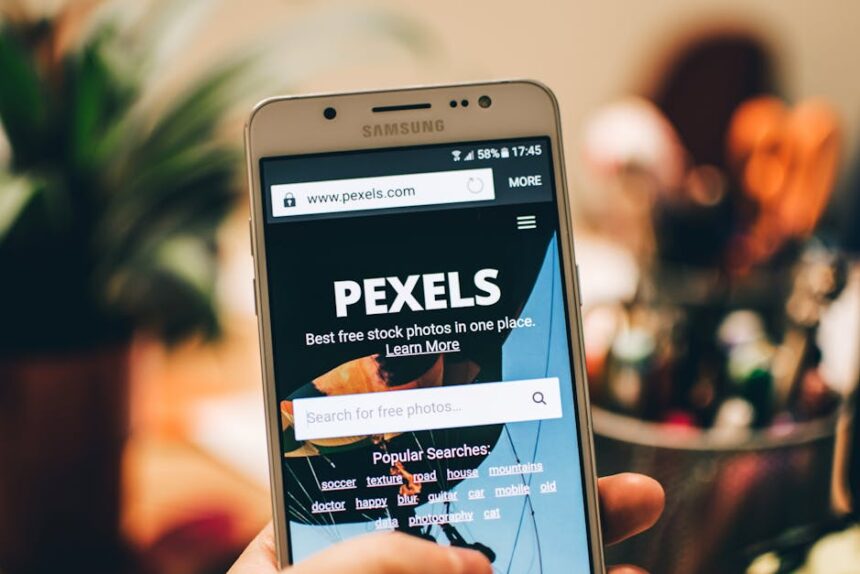Optimizing websites for mobile search is no longer just about responsive design; it has evolved into a comprehensive strategy where user experience metrics, particularly Google’s Core Web Vitals, play a pivotal role. These metrics – Largest Contentful Paint (LCP), First Input Delay (FID), and Cumulative Layout Shift (CLS) – are critical components of Google’s Page Experience signal, directly influencing search rankings on mobile devices. Ensuring an excellent mobile user experience translates directly to higher visibility, lower bounce rates, and improved conversion rates. Understanding and meticulously addressing each of these vital signals is paramount for any digital entity aiming for sustained success in the mobile-first indexing era.
Understanding Core Web Vitals for Mobile Search Excellence
Core Web Vitals represent a fundamental shift in how search engines evaluate the quality of a user’s experience on a webpage. They provide quantifiable, actionable insights into how quickly a page loads, how interactive it is, and how visually stable its content remains during loading. For mobile search, where connectivity can be inconsistent and device processing power varies widely, these metrics are even more critical. Google explicitly states that these signals are part of its ranking algorithm, making their optimization a direct SEO imperative for mobile-first indexing.
Largest Contentful Paint (LCP): Measuring Load Speed Perceptually
LCP measures the time it takes for the largest content element in the viewport to become visible. This could be an image, a video, a large block of text, or a heading. It’s a user-centric metric because it aims to capture when the main content of the page has likely loaded, giving the user a sense that the page is useful. For a good user experience and positive mobile SEO signal, LCP should occur within 2.5 seconds of when the page first starts loading. Anything over 4.0 seconds is considered poor. On mobile, where network conditions can be variable and processing power less robust than desktop, achieving a fast LCP is often more challenging but also more impactful on user retention. A slow LCP directly contributes to a higher bounce rate and a negative perception of site quality, which Google’s algorithms can detect and factor into ranking decisions. Mobile users are notoriously impatient; delays in content rendering can lead to immediate abandonment, impacting organic traffic and business objectives.
First Input Delay (FID): Quantifying Responsiveness
FID measures the time from when a user first interacts with a page (e.g., clicking a link, tapping a button, using a custom, JavaScript-powered control) to the time when the browser is actually able to begin processing that interaction. This metric is crucial because it assesses a page’s responsiveness to user input, particularly during the initial loading phase when the browser’s main thread is often busy parsing and executing JavaScript. A good FID score is 100 milliseconds or less. Anything over 300 milliseconds is poor. FID captures the “jankiness” or unresponsiveness users might experience, which is particularly irritating on mobile devices where touch interactions are prevalent. While FID cannot be measured accurately in lab environments like Lighthouse (as it requires real user interaction), it is a critical field metric reported in the Chrome User Experience Report (CrUX). A high FID signals to users that a page is sluggish and frustrating to interact with, potentially leading to immediate exit and a negative ranking signal for mobile search. Poor FID is often a symptom of excessive JavaScript execution blocking the main thread, especially problematic on less powerful mobile processors.
Cumulative Layout Shift (CLS): Ensuring Visual Stability
CLS measures the total sum of all unexpected layout shifts that occur during the entire lifespan of a page. A layout shift occurs when a visible element changes its start position from one rendered frame to the next. Unexpected shifts are jarring and frustrating, leading users to accidentally click the wrong element or lose their place while reading. For a good user experience, pages should maintain a CLS score of 0.1 or less. Anything over 0.25 is poor. CLS is especially relevant for mobile interfaces where screen real estate is limited, and users are more susceptible to unexpected content movement. Imagine trying to tap a button on your phone, and suddenly an advertisement loads above it, pushing the button down and causing you to tap something else entirely. This is a common and highly frustrating experience that CLS aims to quantify and mitigate. For mobile SEO, a high CLS score indicates a poor user experience, which can negatively affect rankings. It also impacts usability, potentially reducing engagement and increasing bounce rates. Google emphasizes visual stability as a key indicator of a high-quality mobile experience.
Measuring Core Web Vitals for Mobile Performance
Accurate measurement is the first step toward effective optimization. Core Web Vitals data is available through various tools, each offering different insights into your site’s performance for mobile users. Understanding the distinction between “lab data” and “field data” is crucial for a holistic view.
Lab Data vs. Field Data
- Lab Data: This is performance data collected in a controlled environment with predefined settings (e.g., device type, network speed). Tools like Lighthouse and PageSpeed Insights provide lab data. While useful for debugging and identifying specific performance bottlenecks, lab data doesn’t fully capture real-world user experiences, especially considering the vast array of mobile devices and network conditions. It’s excellent for reproducible testing during development.
- Field Data (Real User Monitoring – RUM): This data is collected from actual users visiting your website in the wild. It reflects real-world conditions, including varying network speeds, device capabilities, and geographical locations. Field data, particularly from the Chrome User Experience Report (CrUX), is what Google uses for its Core Web Vitals ranking signals. Google Search Console’s Core Web Vitals report relies entirely on CrUX data.
Key Tools for Measuring Core Web Vitals on Mobile
-
Google Search Console (GSC) Core Web Vitals Report: This is your primary source for understanding how Google perceives your site’s Core Web Vitals performance based on real user data (CrUX). It breaks down URLs into “Good,” “Needs improvement,” and “Poor” categories, allowing you to identify specific pages that require attention on mobile. The report differentiates between mobile and desktop performance, highlighting mobile-specific issues. It’s a powerful diagnostic tool for long-term monitoring and impact assessment. GSC’s report provides a high-level overview of aggregate performance, identifying patterns across groups of similar pages.
-
PageSpeed Insights (PSI): This tool provides both lab data (powered by Lighthouse) and field data (CrUX) for individual URLs. When analyzing a mobile page, PSI simulates a throttled 3G network and a mid-range mobile device. It offers detailed diagnostic information, including specific opportunities for improvement and estimated savings in loading time. PSI is invaluable for debugging specific page performance issues on mobile and seeing how changes might impact your scores. It presents both LCP, FID, and CLS scores, along with other performance metrics and actionable recommendations.
-
Lighthouse: Integrated directly into Chrome DevTools, Lighthouse provides a comprehensive audit of a web page, including performance, accessibility, SEO, and best practices. It generates lab data, simulating mobile conditions by default. Lighthouse reports are incredibly detailed, offering specific recommendations for improving LCP, FID, and CLS, along with an audit of other vital page speed factors. Developers can run Lighthouse locally during development cycles to catch issues before deployment, ensuring that mobile performance is baked into the development process.
-
Chrome DevTools Performance Panel: For advanced debugging, the Performance panel in Chrome DevTools allows developers to record a page load and interaction, then analyze the event log, JavaScript execution, network requests, and rendering frames. This deep dive is crucial for identifying the precise moments causing layout shifts, long tasks blocking the main thread, or slow LCP element rendering. It enables granular analysis that goes beyond what automated tools can provide. Emulating mobile devices within DevTools provides a realistic testing environment.
-
Web Vitals Chrome Extension: This browser extension displays Core Web Vitals metrics for any page you visit in real-time, based on live field data (if available) or calculated lab data. It’s a quick way to get a live snapshot of a page’s performance without opening a separate tool. This is particularly useful for quickly checking competitor performance or validating fixes on your own site.
-
CrUX Dashboard on Data Studio: For more advanced analysis and trend tracking, you can set up a custom dashboard using the CrUX dataset in Google Data Studio (now Looker Studio). This allows you to visualize your site’s Core Web Vitals performance over time, segment by country, device type (mobile vs. desktop), and track the impact of optimizations on real user experiences at scale. This level of granularity is essential for large sites managing a continuous improvement process.
By combining insights from these tools – using GSC for high-level mobile performance monitoring, PSI and Lighthouse for detailed diagnostics, and DevTools for deep-dive debugging – you can establish a robust strategy for improving your site’s Core Web Vitals on mobile and, consequently, its mobile search performance.
Strategies for Improving Largest Contentful Paint (LCP) on Mobile
LCP is largely influenced by four factors: server response time, resource load times, render-blocking resources, and client-side rendering. Optimizing these areas is critical for fast mobile page loads.
-
Improve Server Response Time (TTFB – Time to First Byte):
- Choose a High-Performance Hosting Provider: The foundation of a fast website is robust hosting. Opt for providers known for speed, reliability, and global reach (if your audience is dispersed). Shared hosting can often be slow; consider VPS, dedicated servers, or cloud hosting (AWS, Google Cloud, Azure) for better performance, especially under load.
- Utilize a Content Delivery Network (CDN): A CDN stores cached versions of your website’s static assets (images, CSS, JavaScript) on servers located geographically closer to your users. This significantly reduces latency, delivering content faster to mobile users worldwide. For mobile search, where network latency can be a significant factor, a CDN is indispensable.
- Implement Server-Side Caching: Caching mechanisms at the server level (e.g., Varnish, Redis, Memcached for dynamic content, or robust file caching for static content) can drastically reduce the time it takes for your server to respond. When a page is requested, if a cached version is available, the server doesn’t have to regenerate it from scratch, leading to near-instantaneous responses.
- Optimize Database Queries: For dynamic websites, inefficient database queries can bottleneck server response. Optimize SQL queries, add appropriate indexes, and consider database caching to speed up data retrieval.
- Keep Server Software Up-to-Date: Running the latest versions of PHP, Node.js, Python, or other server-side languages, along with updated web servers like Nginx or Apache, often brings performance improvements and security enhancements.
-
Optimize Resource Load Times (Images, Videos, Fonts):
- Image Optimization:
- Compress Images: Use tools like ImageOptim, TinyPNG, or online compressors to reduce file sizes without sacrificing noticeable quality. This is paramount for mobile, where bandwidth is often limited.
- Choose Modern Formats: Utilize modern image formats like WebP or AVIF. WebP can offer 25-35% smaller file sizes than JPEG or PNG for equivalent quality. AVIF is even more efficient. Serve these formats using the
element with fallbacks for older browsers. - Responsive Images (
srcsetandsizes): Serve different image resolutions based on the user’s device and viewport. Thesrcsetattribute specifies a list of image files with their intrinsic widths, andsizesdescribes how the image should be displayed. This ensures mobile users download only the image resolution appropriate for their smaller screens, saving bandwidth and improving LCP. - Lazy Loading: Implement native lazy loading (
loading="lazy") for images and iframes that are below the fold. This prevents resources from being loaded until they are needed, prioritizing above-the-fold content (including the LCP element). For images that are likely to be the LCP element, ensure they are not lazy-loaded. - Preload LCP Image: If your LCP element is an image, use
in theto tell the browser to fetch it as a high-priority resource, even before the CSS or JavaScript that might define its properties.
- Video Optimization: Use efficient video formats, compress them, and consider streaming services that adapt quality to network conditions. Lazy load videos whenever possible.
- Font Optimization:
- Self-Host Fonts: Hosting fonts on your own server can sometimes be faster than relying on third-party services like Google Fonts, allowing for better control over caching and delivery.
- Font Formats: Use modern font formats like WOFF2, which are highly compressed. Provide fallbacks for older browsers.
font-displayProperty: Usefont-display: swap;in your@font-faceCSS. This tells the browser to use a fallback system font immediately, and swap it with the custom font once it’s loaded. This prevents FOIT (Flash of Invisible Text) and ensures text is visible faster, reducing LCP delay for text-based LCP elements.- Preload Critical Fonts: If certain fonts are essential for the LCP element or above-the-fold content, use
to fetch them early.
- Image Optimization:
-
Minimize Render-Blocking Resources:
- Critical CSS: Extract the CSS necessary for above-the-fold content and inline it directly into the HTML. This allows the browser to render the critical parts of the page immediately without waiting for an external CSS file to download. Defer the loading of the remaining (non-critical) CSS. Tools like PurgeCSS or dedicated plugins can help automate this.
- Defer Non-Critical JavaScript:
- Use the
deferattribute for JavaScript files that don’t need to execute during the initial page load. This tells the browser to download the script in the background and execute it after the HTML parsing is complete, but before theDOMContentLoadedevent. - Use the
asyncattribute for scripts that are independent of other scripts and the HTML structure (e.g., analytics scripts). These scripts are downloaded asynchronously and executed as soon as they are available, potentially interrupting HTML parsing. - Avoid placing
tags in theunless they are critical for initial rendering (e.g., polyfills or scripts that modify the DOM before it’s painted). Move them to the end of theor usedefer/async.
- Use the
- Remove Unused CSS/JavaScript: Audit your stylesheets and scripts to remove any code that is not being used. This reduces file size and parsing time. Modern bundlers (Webpack, Rollup) can assist with tree-shaking (removing unused JS) and dead code elimination.
-
Optimize Client-Side Rendering (for Single Page Applications/Frameworks):
- Server-Side Rendering (SSR) or Static Site Generation (SSG): For JavaScript-heavy frameworks (React, Vue, Angular), client-side rendering can delay LCP because the browser needs to download, parse, and execute JavaScript before it can render content. Implementing SSR or SSG generates the initial HTML on the server, sending a fully formed page to the browser. This allows content to be painted much faster, leading to a significantly improved LCP. The JavaScript can then “hydrate” the page for interactivity.
- Pre-rendering: Similar to SSG, pre-rendering generates static HTML files for specific routes during build time. This is effective for marketing pages or content that doesn’t change frequently.
- Code Splitting: Break down your JavaScript bundles into smaller chunks. This allows the browser to download and parse only the code needed for the current view, delaying the loading of other components until they are required. This is particularly beneficial for large mobile applications.
- Minimize Main Thread Work: Heavy JavaScript execution can block the main thread, delaying rendering. Optimize JavaScript code to be more efficient, reduce long tasks, and use Web Workers for computationally intensive operations that can run in the background.
Strategies for Improving First Input Delay (FID) on Mobile
FID is directly related to the browser’s main thread being busy. When the main thread is occupied by heavy JavaScript execution or parsing, it cannot respond to user input, leading to a high FID. Optimizing FID on mobile involves making your page interactive as quickly as possible.
-
Reduce JavaScript Execution Time:
- Code Splitting: As mentioned for LCP, splitting large JavaScript bundles into smaller, on-demand chunks (e.g., per route or component) reduces the amount of JavaScript that needs to be downloaded, parsed, and executed initially. This frees up the main thread sooner.
- Lazy Load JavaScript: Defer loading JavaScript that isn’t immediately necessary for interactivity. This can include scripts for analytics, social media widgets, advertisements, or complex UI components that appear below the fold. Load them only when the user scrolls into view or after the page is fully interactive.
- Minify and Compress JavaScript: Minification removes unnecessary characters (whitespace, comments) from code, reducing file size. Compression (Gzip or Brotli) further reduces transfer size. Smaller files download faster and parse quicker, freeing the main thread.
- Eliminate Unused JavaScript: Audit your codebase regularly to identify and remove dead code. Tools like Chrome DevTools Coverage tab can help pinpoint unused bytes in your JavaScript and CSS files.
- Optimize Third-Party Scripts: Third-party scripts (analytics, ads, chat widgets, A/B testing, trackers) are common culprits for high FID.
- Audit Third-Party Scripts: Identify which scripts are truly necessary and remove redundant ones.
- Load Asynchronously/Defer: Use
asyncordeferattributes for all third-party scripts. - Host Locally (where permissible): For some third-party scripts, hosting them locally can give you more control over caching and delivery, but be mindful of update mechanisms.
- Use Resource Hints: For critical third-party origins, use
andto establish early connections, reducing setup time. - Implement Facades: For scripts like YouTube embeds or social media widgets, load a lightweight “facade” (a static image) first. Only load the actual heavy script when the user explicitly interacts with the facade (e.g., clicks the play button).
-
Break Up Long Tasks:
- Yield to the Main Thread: JavaScript tasks that run for more than 50 milliseconds are considered “long tasks” and can block the main thread, leading to unresponsiveness. Break these long tasks into smaller, asynchronous chunks.
- Use
requestIdleCallbackorsetTimeout: For non-essential, low-priority tasks, schedule them to run when the browser is idle usingrequestIdleCallback. For tasks that need to run eventually but not immediately,setTimeout(..., 0)can yield control back to the main thread. - Web Workers: For computationally intensive JavaScript operations that don’t need DOM access (e.g., complex calculations, data processing), move them to a Web Worker. Web Workers run on a separate thread, preventing them from blocking the main thread and ensuring the UI remains responsive.
-
Prioritize User-Critical Interactivity:
- Identify Critical JavaScript: Determine which JavaScript is absolutely essential for the initial user interaction on mobile. Prioritize the loading and execution of this critical code.
- Avoid Excessive DOM Manipulation During Load: Heavy manipulation of the Document Object Model (DOM) during the initial load phase can consume significant main thread time. Perform DOM changes efficiently and batch them where possible.
- Optimize Event Listeners: Be mindful of how many event listeners you have and what they do. Debounce or throttle event handlers for events like
scrollorresizeto prevent them from firing too frequently and causing performance bottlenecks.
-
Utilize Resource Hints:
preconnect: For critical third-party domains (e.g., API endpoints, analytics providers, font hosts), useto tell the browser to establish an early connection, including DNS lookup, TCP handshake, and TLS negotiation. This reduces latency when fetching resources from that origin.dns-prefetch: A slightly less impactful hint thanpreconnect,dns-prefetchonly performs the DNS lookup, but can be useful for domains that you know you’ll need to connect to but perhaps not immediately.
Strategies for Improving Cumulative Layout Shift (CLS) on Mobile
CLS is often caused by dynamically loaded content, images without dimensions, and fonts. Mitigating these unexpected shifts is crucial for a stable and predictable mobile experience.
-
Specify Dimensions for Images and Videos:
widthandheightAttributes: Always includewidthandheightattributes on yourtags. This tells the browser how much space to reserve for the media before it loads, preventing layout shifts.- CSS
aspect-ratioProperty: Modern CSS offers theaspect-ratioproperty, which allows you to define the width-to-height ratio for an element. This is particularly useful for responsive images where fixed pixel dimensions aren’t always suitable. For example,img { aspect-ratio: 16 / 9; }will maintain a 16:9 ratio, reserving the correct space dynamically. This is the preferred method for responsive designs. pictureElement with Multiple Sources: When using theelement withsrcsetfor responsive images, ensure that eachsourceelement withinand the fallbackimgelement explicitly define width and height attributes or use CSS aspect-ratio.
-
Handle Dynamically Injected Content (Ads, Embeds, Banners):
- Reserve Space: For advertisements, embeddable widgets (e.g., social media feeds, maps), or promotional banners that load dynamically, always reserve sufficient space for them in the layout before they load.
- Fixed Height/Min-Height: If the ad or embed has a known size, apply a fixed
heightormin-heightto its container element. - Placeholders: Use placeholder elements that occupy the final dimensions of the dynamic content.
- Calculate Space Dynamically: For more complex scenarios where ad sizes vary, you might need JavaScript to determine the available space and apply it, but do this as early as possible and avoid doing it after the content above it has rendered.
- Fixed Height/Min-Height: If the ad or embed has a known size, apply a fixed
- Avoid Inserting Content Above Existing Content: Never inject new content (like signup forms, cookies notices, or promotional banners) at the top of the viewport after the page has started rendering. This will push down existing content, causing a significant layout shift. If such elements are necessary, ensure they are placed above the main content from the initial render or use an overlay that doesn’t affect the document flow.
- Use “Sticky” Elements Carefully: While fixed position elements (like sticky headers or footers) don’t contribute to CLS (as they are taken out of the normal document flow), pay attention to how they interact with the content below them. If a sticky element appears unexpectedly, it can still be jarring to the user.
- Reserve Space: For advertisements, embeddable widgets (e.g., social media feeds, maps), or promotional banners that load dynamically, always reserve sufficient space for them in the layout before they load.
-
Optimize Web Fonts:
font-displayRevisited: Whilefont-display: swap;is good for LCP, it can cause a “Flash of Unstyled Text” (FOUT) where text initially renders in a fallback font and then swaps to the custom font once loaded. This swap can cause a CLS if the fallback font’s metrics (width, height, kerning) are significantly different from the custom font.- Preload Critical Fonts: Preloading fonts ensures they are available earlier, reducing the time a fallback font is displayed.
size-adjust,ascent-override,descent-override,line-gap-override: These advanced CSS properties allow you to fine-tune font metrics to minimize the visual difference between a fallback font and your custom web font. By adjusting the size and vertical metrics, you can ensure that the text space occupied by the fallback font is very close to that of the custom font, preventing layout shifts when the swap occurs. This requires careful measurement and adjustment.- Critical Font Subsetting: Only load the characters and weights of a font that are truly needed for your content. Subsetting can drastically reduce font file sizes.
-
Avoid Uncontrolled Animations and Transitions:
- Use CSS Transforms for Animations: When animating elements, use CSS
transformproperties (e.g.,transform: translateX(),scale()) instead of properties that trigger layout changes (e.g.,top,left,width,height). Transforms operate on the composite layer and don’t trigger reflows, ensuring smoother, CLS-free animations. - Avoid Animating
autoDimensions: Do not animate properties likeheight: autoorwidth: auto, as this will cause layout shifts. If you must animate dimensions, animate from a fixed value to another fixed value.
- Use CSS Transforms for Animations: When animating elements, use CSS
-
Be Mindful of Dynamic Content Above the Fold:
- Client-side widgets: Chatbots, cookie consent banners, newsletters pop-ups, and other dynamic elements often appear unexpectedly. For elements that must appear, ensure they don’t push down existing content. Use modal overlays, fixed positioning, or ensure their space is reserved.
- A/B Testing Tools: Some A/B testing tools can inject content or modify the DOM in ways that cause layout shifts. Work with your A/B testing provider to understand their implementation and mitigate CLS. Ensure variations are applied as early as possible or use server-side rendering for variations to prevent flickering.
Holistic Mobile Performance and Core Web Vitals
Improving Core Web Vitals for mobile search is not a one-time task but an ongoing process that requires continuous monitoring, testing, and iteration. It involves a holistic approach to web performance, considering various aspects beyond the three core metrics themselves.
-
Mobile-First Indexing Considerations: Google primarily uses the mobile version of your content for indexing and ranking. This reinforces the necessity of prioritizing mobile Core Web Vitals. Any optimizations applied to the desktop version should ideally also be reflected and verified on the mobile version. Ensure that all critical content and functionalities are available and performant on your mobile site.
-
AMP vs. Progressive Web Apps (PWAs) vs. Traditional Responsive:
- AMP (Accelerated Mobile Pages): AMP is a framework for creating fast-loading mobile pages, often cached by Google. It enforces strict rules that inherently lead to good Core Web Vitals. While AMP delivers speed, it can restrict design flexibility and might not be suitable for all types of content. It’s often used for news and publishing.
- PWAs: PWAs leverage modern web capabilities (like Service Workers for caching and offline access, push notifications) to deliver an app-like experience in the browser. A well-built PWA can achieve excellent Core Web Vitals, offering instant loading and responsiveness once assets are cached.
- Traditional Responsive Design: Most websites fall into this category. With careful optimization, a standard responsive site can also achieve excellent Core Web Vitals scores, offering full design freedom and broad browser compatibility. The choice depends on your specific needs, but the underlying principles of performance optimization remain the same across all three.
-
HTTP/2 and HTTP/3 Adoption: Ensure your server is configured to use HTTP/2, which offers multiplexing (multiple requests over a single connection) and header compression, significantly improving resource loading times compared to HTTP/1.1. HTTP/3, the latest iteration built on QUIC, offers further performance gains, especially over unreliable mobile networks, by reducing connection setup latency and improving stream multiplexing. Consult with your hosting provider to ensure these protocols are enabled.
-
Service Workers for Caching and Offline Capabilities: For PWAs or sites that aim for offline capabilities, Service Workers can cache assets (HTML, CSS, JS, images) aggressively. Once assets are cached, subsequent visits can load instantly from the cache, bypassing the network entirely and resulting in near-perfect LCP and FID scores. Service Workers also enable features like background synchronization and push notifications, enhancing mobile user experience.
-
Regular Auditing and Monitoring: Web performance is dynamic. As content changes, features are added, or third-party scripts update, performance can degrade. Implement a routine for:
- Automated Testing: Integrate Lighthouse or PageSpeed Insights checks into your CI/CD pipeline to catch performance regressions before they go live.
- Real User Monitoring (RUM): Beyond Google Search Console, consider dedicated RUM solutions (e.g., DataDog, New Relic, or open-source solutions like Boomerang.js) to gather granular field data specific to your user base, allowing for deeper insights into real-world performance.
- Performance Budgeting: Establish performance budgets for metrics like page weight, JavaScript size, and LCP time. Alert your team when these budgets are exceeded, making performance a measurable and accountable part of the development process.
-
User Experience (UX) Beyond Metrics: While Core Web Vitals provide objective measures, remember the ultimate goal is an excellent user experience. A site might technically pass all CWV scores but still be frustrating due to poor navigation, confusing layouts, or irrelevant content. Always iterate based on user feedback and observed behavior patterns. Core Web Vitals are a strong foundation, but they are part of a larger UX puzzle. For mobile search, a positive UX reinforces user trust, increases dwell time, and reduces bounce rates, signaling to search engines that your site is valuable.
-
Content Prioritization: Not all content on a page is equally important. Prioritize the loading and rendering of critical content (what the user came for) over non-essential elements. This ties into optimizing LCP by ensuring the largest content element is the most important one and loads quickly. For mobile users, getting the key information or functionality quickly is paramount.
-
Server-Side Rendering (SSR) for Dynamic Content: For websites built with client-side JavaScript frameworks (React, Vue, Angular), client-side rendering (CSR) can significantly delay content visibility and interactivity, leading to poor LCP and FID. Implementing Server-Side Rendering (SSR) allows the server to pre-render the initial HTML for the page, sending a fully formed page to the browser. This means the user sees content much faster and the page becomes interactive more quickly, as the browser doesn’t have to wait for JavaScript to execute to build the DOM. This is particularly beneficial for mobile devices with slower CPUs.
-
Efficient CSS Delivery: Beyond critical CSS, consider the overall efficiency of your stylesheets.
- Minify and Compress: Just like JavaScript, minify and compress your CSS files.
- Remove Unused CSS: Use tools to identify and eliminate unused CSS rules across your site. Unused CSS increases file size and parse time.
- Consolidate Stylesheets: Reduce the number of HTTP requests by combining multiple CSS files into one, but be careful not to create a massive file that delays rendering. Balancing critical CSS inlining with efficient external file loading is key.
- Avoid
@import: The@importrule in CSS is render-blocking and should be avoided in favor oftags.
By diligently applying these strategies and maintaining a continuous focus on performance, particularly for the unique challenges of mobile environments, websites can significantly improve their Core Web Vitals. This commitment directly translates into enhanced user satisfaction, lower bounce rates, higher engagement, and ultimately, superior rankings in mobile search results, ensuring a strong competitive advantage in the digital landscape. The pursuit of optimal Core Web Vitals is not merely a technical exercise; it is an investment in the long-term success of your online presence, fundamentally shaping how your audience experiences and interacts with your brand on their mobile devices.











